The Mosquito-borne infections Testing Market is estimated to be valued at USD 1.3 billion in 2025 and is projected to reach USD 2.1 billion by 2035, registering a compound annual growth rate (CAGR) of 5.2% over the forecast period.
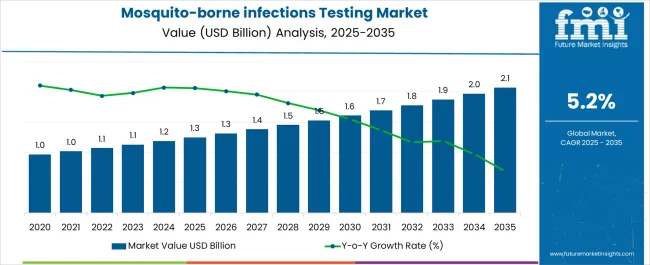
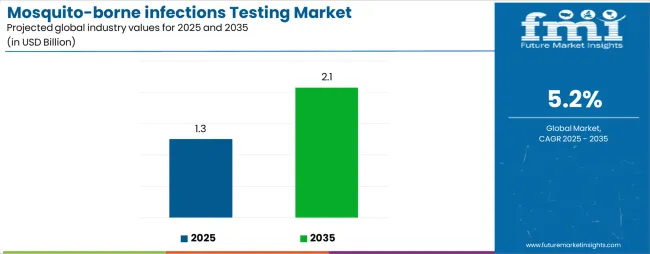
| Metric | Value |
|---|---|
| Mosquito-borne infections Testing Market Estimated Value in (2025 E) | USD 1.3 billion |
| Mosquito-borne infections Testing Market Forecast Value in (2035 F) | USD 2.1 billion |
| Forecast CAGR (2025 to 2035) | 5.2% |
The mosquito-borne infections testing market is gaining traction due to the persistent global burden of diseases such as malaria, dengue, chikungunya, and Zika, which continue to impact millions of people annually. The rising prevalence of these infections, coupled with expanding geographic spread caused by climate change, urbanization, and increasing international travel, is driving demand for advanced diagnostic testing.
Current market momentum is being reinforced by heightened government initiatives, public health surveillance programs, and investments aimed at early detection and control of outbreaks. Molecular diagnostics and rapid testing kits are being increasingly integrated into healthcare systems to provide timely and accurate results, helping reduce disease transmission rates.
Growing emphasis on universal healthcare access in emerging economies and the continuous innovation in diagnostic platforms are shaping the future of this market With the advancement of portable and cost-effective diagnostic tools, coupled with digital connectivity for real-time reporting, the mosquito-borne infections testing market is projected to expand further, supporting timely intervention strategies and improved patient outcomes globally.
The mosquito-borne infections testing market is segmented by test type, indication, end users, and geographic regions. By test type, mosquito-borne infections testing market is divided into Molecular Diagnostics, Immunoassay Systems, ELISA, Rapid Tests, Blot Systems And Evaluation Software, and Microspot Array Diagnostics. In terms of indication, mosquito-borne infections testing market is classified into Malaria, Zika Virus, Chikungunya, Dengue, and Others. Based on end users, mosquito-borne infections testing market is segmented into Hospitals And Clinics, Private Commercial Laboratories, Academic And Research Centers, and Others. Regionally, the mosquito-borne infections testing industry is classified into North America, Latin America, Western Europe, Eastern Europe, Balkan & Baltic Countries, Russia & Belarus, Central Asia, East Asia, South Asia & Pacific, and the Middle East & Africa.
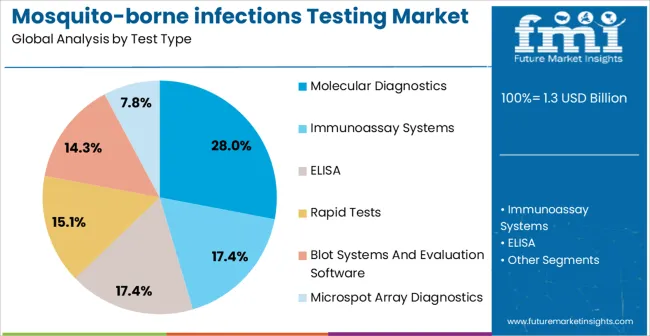
The molecular diagnostics test type is projected to account for 28.00% of the mosquito-borne infections testing market revenue in 2025, positioning it as the leading segment by technology. The growth of this segment is being attributed to its ability to deliver highly sensitive and specific results, enabling accurate identification of pathogens at the genetic level.
Molecular testing has become critical in early-stage detection, where traditional microscopy or serology may fall short in differentiating between infections or detecting low parasite loads. The adoption of PCR-based techniques and next-generation molecular assays has been reinforced by the need for rapid results during outbreaks, ensuring timely treatment and containment measures.
Healthcare systems and laboratories are increasingly relying on molecular diagnostics due to their scalability, automation potential, and compatibility with multiplex testing platforms that allow simultaneous detection of multiple pathogens The demand for such solutions has been further supported by global health initiatives aiming to strengthen diagnostic infrastructure in endemic regions, making molecular diagnostics a central pillar of mosquito-borne infection testing.

The malaria indication segment is expected to hold 35.00% of the mosquito-borne infections testing market revenue in 2025, making it the dominant segment among disease types. The segment’s leadership is being driven by the continued high prevalence of malaria in endemic regions across Africa, Asia, and parts of Latin America. Malaria remains one of the most widely diagnosed mosquito-borne diseases, creating sustained demand for accurate and accessible testing solutions.
Efforts by governments and global health organizations to meet elimination targets have reinforced the use of advanced diagnostics in both clinical and field settings. Molecular and rapid diagnostic tests have been prioritized for their ability to detect asymptomatic carriers and drug-resistant strains, ensuring targeted treatment strategies.
The expansion of funding programs for malaria control, coupled with rising awareness about early detection, has further supported growth in this segment As integrated surveillance systems become more prevalent, the malaria indication is expected to continue dominating, supported by ongoing innovation and accessibility initiatives.
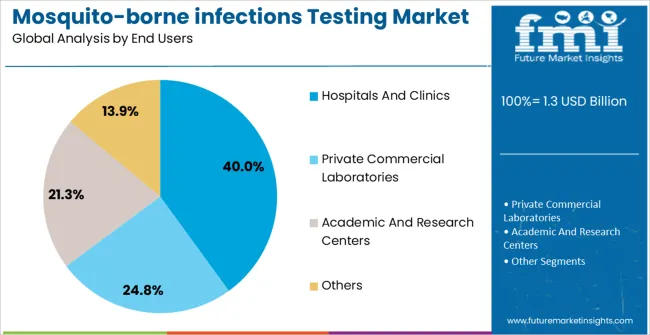
The hospitals and clinics end user segment is anticipated to capture 40.00% of the mosquito-borne infections testing market revenue in 2025, making it the largest consumer base. This dominance is being attributed to the availability of advanced diagnostic infrastructure, skilled medical professionals, and the high patient inflow in these settings. Hospitals and clinics serve as the first point of care for individuals presenting symptoms of mosquito-borne infections, driving consistent demand for accurate and rapid testing solutions.
The ability of hospitals to integrate laboratory-based molecular diagnostics and point-of-care rapid testing allows timely patient management and better clinical outcomes. Additionally, hospitals and clinics often act as reporting hubs within public health surveillance networks, further reinforcing their central role in large-scale monitoring and outbreak management.
The trust placed by patients in these institutions, combined with ongoing investments in diagnostic technologies, has ensured that hospitals and clinics remain the preferred centers for mosquito-borne infection testing The segment’s growth is expected to continue as healthcare systems strengthen their preparedness for vector-borne disease outbreaks.
One of the biggest public growing threat called mosquito-borne infections is booming worldwide with over one million deaths every year. Infections transmitted through travels and environmental changes possess a strong impact and has increased considerably over the years.
Mosquito-borne infections are caused by bacteria, viruses, or parasites transmitted by mosquitoes. Mosquito-borne infections testing is generally differentiated based on the type of infections namely: mosquito-borne infections testing for dengue, mosquito-borne infections testing for zika virus, mosquito-borne infections testing for chikungunya, and mosquito-borne infections testing for malaria.
Mosquito-borne infections testing is considered as the primary mode of diagnosis for mosquito-borne infections. Mosquito-borne infections testing is easily available at healthcare facilities. There are multiple mosquito-borne infections which show similar symptoms like muscle and joint pain and febrile illness.
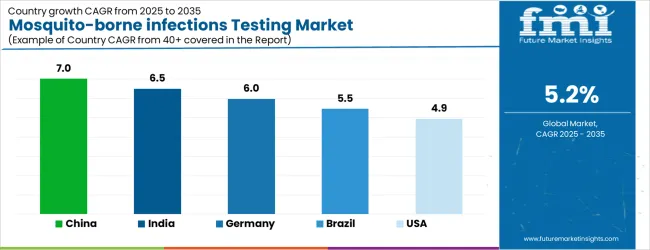
| Country | CAGR |
|---|---|
| China | 7.0% |
| India | 6.5% |
| Germany | 6.0% |
| Brazil | 5.5% |
| USA | 4.9% |
| UK | 4.4% |
| Japan | 3.9% |
The Mosquito-borne infections Testing Market is expected to register a CAGR of 5.2% during the forecast period, exhibiting varied country level momentum. China leads with the highest CAGR of 7.0%, followed by India at 6.5%. Developed markets such as Germany, France, and the UK continue to expand steadily, while the USA is likely to grow at consistent rates. Japan posts the lowest CAGR at 3.9%, yet still underscores a broadly positive trajectory for the global Mosquito-borne infections Testing Market.
In 2024, Germany held a dominant revenue in the Western Europe market and is expected to grow with a CAGR of 6.0%. The USA Mosquito-borne infections Testing Market is estimated to be valued at USD 451.1 million in 2025 and is anticipated to reach a valuation of USD 451.1 million by 2035. Sales are projected to rise at a CAGR of 0.0% over the forecast period between 2025 and 2035. While Japan and South Korea markets are estimated to be valued at USD 65.5 million and USD 36.1 million respectively in 2025.
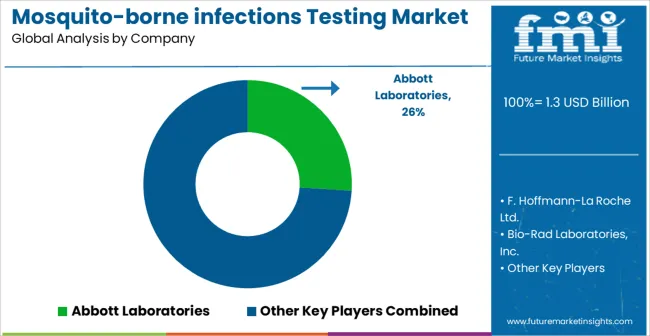
| Item | Value |
|---|---|
| Quantitative Units | USD 1.3 Billion |
| Test Type | Molecular Diagnostics, Immunoassay Systems, ELISA, Rapid Tests, Blot Systems And Evaluation Software, and Microspot Array Diagnostics |
| Indication | Malaria, Zika Virus, Chikungunya, Dengue, and Others |
| End Users | Hospitals And Clinics, Private Commercial Laboratories, Academic And Research Centers, and Others |
| Regions Covered | North America, Europe, Asia-Pacific, Latin America, Middle East & Africa |
| Country Covered | United States, Canada, Germany, France, United Kingdom, China, Japan, India, Brazil, South Africa |
| Key Companies Profiled | Abbott Laboratories, F. Hoffmann-La Roche Ltd., Bio-Rad Laboratories, Inc., Siemens Healthineers AG, Qiagen N.V., Thermo Fisher Scientific Inc., Cepheid (Danaher Corporation), and DiaSorin S.p.A. |
The global mosquito-borne infections testing market is estimated to be valued at USD 1.3 billion in 2025.
The market size for the mosquito-borne infections testing market is projected to reach USD 2.1 billion by 2035.
The mosquito-borne infections testing market is expected to grow at a 5.2% CAGR between 2025 and 2035.
The key product types in mosquito-borne infections testing market are molecular diagnostics, immunoassay systems, elisa, rapid tests, blot systems and evaluation software and microspot array diagnostics.
In terms of indication, malaria segment to command 35.0% share in the mosquito-borne infections testing market in 2025.






Our Research Products

The "Full Research Suite" delivers actionable market intel, deep dives on markets or technologies, so clients act faster, cut risk, and unlock growth.

The Leaderboard benchmarks and ranks top vendors, classifying them as Established Leaders, Leading Challengers, or Disruptors & Challengers.

Locates where complements amplify value and substitutes erode it, forecasting net impact by horizon

We deliver granular, decision-grade intel: market sizing, 5-year forecasts, pricing, adoption, usage, revenue, and operational KPIs—plus competitor tracking, regulation, and value chains—across 60 countries broadly.

Spot the shifts before they hit your P&L. We track inflection points, adoption curves, pricing moves, and ecosystem plays to show where demand is heading, why it is changing, and what to do next across high-growth markets and disruptive tech

Real-time reads of user behavior. We track shifting priorities, perceptions of today’s and next-gen services, and provider experience, then pace how fast tech moves from trial to adoption, blending buyer, consumer, and channel inputs with social signals (#WhySwitch, #UX).

Partner with our analyst team to build a custom report designed around your business priorities. From analysing market trends to assessing competitors or crafting bespoke datasets, we tailor insights to your needs.
Supplier Intelligence
Discovery & Profiling
Capacity & Footprint
Performance & Risk
Compliance & Governance
Commercial Readiness
Who Supplies Whom
Scorecards & Shortlists
Playbooks & Docs
Category Intelligence
Definition & Scope
Demand & Use Cases
Cost Drivers
Market Structure
Supply Chain Map
Trade & Policy
Operating Norms
Deliverables
Buyer Intelligence
Account Basics
Spend & Scope
Procurement Model
Vendor Requirements
Terms & Policies
Entry Strategy
Pain Points & Triggers
Outputs
Pricing Analysis
Benchmarks
Trends
Should-Cost
Indexation
Landed Cost
Commercial Terms
Deliverables
Brand Analysis
Positioning & Value Prop
Share & Presence
Customer Evidence
Go-to-Market
Digital & Reputation
Compliance & Trust
KPIs & Gaps
Outputs
Full Research Suite comprises of:
Market outlook & trends analysis
Interviews & case studies
Strategic recommendations
Vendor profiles & capabilities analysis
5-year forecasts
8 regions and 60+ country-level data splits
Market segment data splits
12 months of continuous data updates
DELIVERED AS:
PDF EXCEL ONLINE
Hemotransmissive Infections Testing Market Size and Share Forecast Outlook 2025 to 2035
Arthropod-borne Viral Infections Testing Market Size and Share Forecast Outlook 2025 to 2035
Testing, Inspection & Certification Market Growth – Trends & Forecast 2025 to 2035
5G Testing Market Size and Share Forecast Outlook 2025 to 2035
AB Testing Software Market Size and Share Forecast Outlook 2025 to 2035
5G Testing Equipment Market Analysis - Size, Growth, and Forecast 2025 to 2035
Eye Testing Equipment Market Size and Share Forecast Outlook 2025 to 2035
HSV Testing Market Size and Share Forecast Outlook 2025 to 2035
IoT Testing Equipment Market Size and Share Forecast Outlook 2025 to 2035
HPV Testing and Pap Test Market Size and Share Forecast Outlook 2025 to 2035
Global Eye Infections Treatment Market Report - Trends & Forecast 2025 to 2035
GMO Testing Services Market Insights – Food Safety & Regulatory Compliance 2024 to 2034
GMP Testing Services Market
LTE Testing Equipment Market Growth – Trends & Forecast 2019-2027
Drug Testing Systems Market Size and Share Forecast Outlook 2025 to 2035
Sand Testing Equipments Market Size and Share Forecast Outlook 2025 to 2035
Tire Testing Machine Market Size and Share Forecast Outlook 2025 to 2035
Self-Testing Market Analysis - Size, Share, and Forecast 2025 to 2035
Food Testing Services Market Size, Growth, and Forecast for 2025–2035
Bend Testing Machine Market Growth - Trends & Forecast 2025 to 2035

Thank you!
You will receive an email from our Business Development Manager. Please be sure to check your SPAM/JUNK folder too.
Chat With
MaRIA